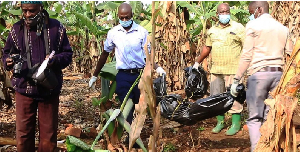 Police detectives carrying the two bodies of the murdered children after they were exhumed from a p
Police detectives carrying the two bodies of the murdered children after they were exhumed from a p
The victims, Julius Asiimwe, 2, and Andrew Jjunju, 6, were kidnapped on June 10, and July 2, respectively, by unknown individuals who demanded a ransom from their parents before murdering the children.
Shock gripped residents of Kasaana C Village, Mateete Rural Sub County, Sembabule District, on Tuesday morning after the bodies of two children were found dumped in a pit latrine.
The victims, Julius Asiimwe, 2, and Andrew Jjunju, 6, were kidnapped on June 10, and July 2, respectively, by unknown individuals who demanded a ransom from their parents before murdering the children. Preliminary police investigations indicate that the victims were buried in the pit latrine by their killers.
Mr Steven Mwesigye, the father of Asiimwe and a resident of Kyambulala Village in Kinwyamazi Parish, Mateete Rural Sub County, reported the first case of kidnapping to Mateete Police Station, prompting police to launch a manhunt for the child in vain. He said Asiimwe went missing around 10 p.m. on June 10. “He walked out of the house for a short call, and we did not see him again,” he said.
On July 3, a similar incident was reported in the same area by Ms. Betty Zalwango, the victim’s aunt, when Jjunju was also kidnapped on his way from St. Herman Kasana Primary School. She reported the matter to the police, and a search for the child commenced.
According to Mr Twaha Kasirye, the southern regional police spokesperson, after recording the two cases, the local police, with the help of detectives from the Flying Squad team, tracked the mobile phone the kidnappers were using to demand a ransom from the victims’ relatives. This led to the arrest of the suspects, who later directed detectives to an abandoned pit latrine where the missing children were buried after being gruesomely murdered.
“Both bodies had started decomposing. Jjunju’s body was found without a tongue and lips, and it was still in its school uniform. Julius's body was in skeleton form, missing eyes, tongue, and mouth. It looked like they were sacrificed for ritual purposes,” he said. He added that police detectives managed to recover the bodies and take them for a postmortem. A total of eight suspects have been arrested over their alleged involvement in the gruesome double murder of juveniles.
“The eight suspects have given us information about the suspected ritual sacrifices, and as police, we strongly condemn such heinous acts resurfacing in our community,” he said. He noted that the suspects will face several charges, including kidnapping, murder, and human sacrifice, when police investigations are concluded.
Cases of suspected human sacrifices are not new in Ugandan society. On July 4, the body of a two-year-old girl, Samali Namuyomba, was discovered in a maize plantation at Wabigalo Cell in Mityana Municipality, Mityana District. The maize plantation belongs to the wife of a witchdoctor. Three suspects—all residents of Mityana Municipality, including two women and one man—are still in custody at Mityana Central Police Station to assist police with investigations.
A couple of months ago, authorities in the neighboring Kiboga District recovered the mutilated body parts of five-year-old Esther Nakasumba and her two-year-old sister, Sylvia Natongo, from a brick furnace near Kasinina Elimu Church, located less than a kilometer from their home in Kirinda Village, Kiboga District. The two had gone missing on April 3 after their parents, whom they had accompanied to their farm, asked them to go back home for lunch, but they never reached their destination.
According to the Prevention and Prohibition of Human Sacrifice Act 2021, human sacrifice and financing the practice are criminal and punishable by death upon conviction. An attempt to commit or finance the offense, as well as spreading the belief in human sacrifice for financial reward or any form of gain, attracts a sentence of life imprisonment.
Some people who visit shrines claim traditional healers use the remains of the dead to cast spells on their clients’ enemies. However, this cannot be elaborately explained by practitioners or proven scientifically.